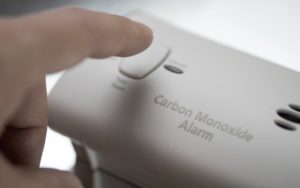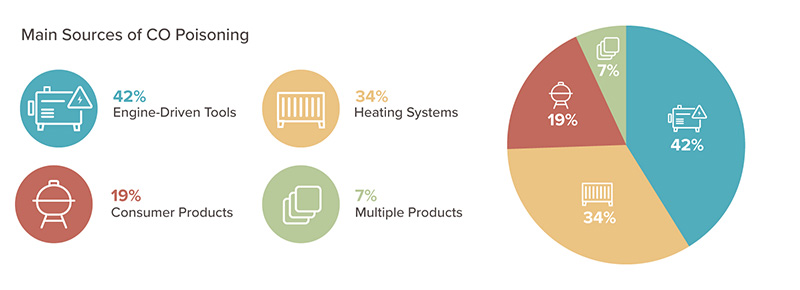Carbon monoxide gas is a simple molecule: one part carbon and one part oxygen. Carbon monoxide comes when carbon fuel—like wood, gasoline, coal, propane, natural gas, and heating oil—fails to burn completely (incomplete combustion).
These energy sources aren’t dangerous when you burn them in an open area with plenty of ventilation. But carbon monoxide is hazardous in confined spaces—like basements, kitchens, garages, or campers.
Carbon monoxide is hard to detect without a sensor, which is one of the reasons it’s so dangerous.
Carbon monoxide is deadly because it binds with your red blood cells and starves your body of oxygen after passing into your lungs.
These are the early symptoms of carbon monoxide poisoning:
- Headache
- Nausea
- Vomiting
- Dizziness
- Shortness of breath
- Fatigue
Perhaps most troubling is the similarity to cold or flu-like symptoms that are easy to ignore—shortness of breath, nausea, and mild headaches. Disorientation and unconsciousness can occur when levels of carbon monoxide reach 150 parts per million (ppm). Eventually, the symptoms turn lethal without treatment.
Carbon monoxide poisoning is a serious risk, but fortunately, it’s preventable. Here are five tips for avoiding exposure, including installing sensors throughout your home.
- Never heat your home with a gas range. Gas stoves produce carbon monoxide and can fill your home with the dangerous gas.
- Don’t run your car in the garage. If you want to warm up your vehicle in the winter, pull out of the garage first. Carbon monoxide is a common byproduct of vehicle exhaust and builds up quickly in a closed (or even open) garage.
- Always have proper ventilation. It’s extremely dangerous to run gas-powered tools (like generators, space heaters, and pressure washers) in an enclosed area like a basement or garage without adequate ventilation.
- Practice cooking safety while camping. You should enjoy the wilderness safely. Don’t use a charcoal grill, hibachi, or camping stove inside your home, tent, or camper. Besides, open flames and fabric tents don’t tend to get along.
- Install a carbon monoxide detector. The best carbon monoxide detectors are affordable, easy to install, and can save your life. We recommend installing one on every level of your home, near each bedroom, and near your garage.


